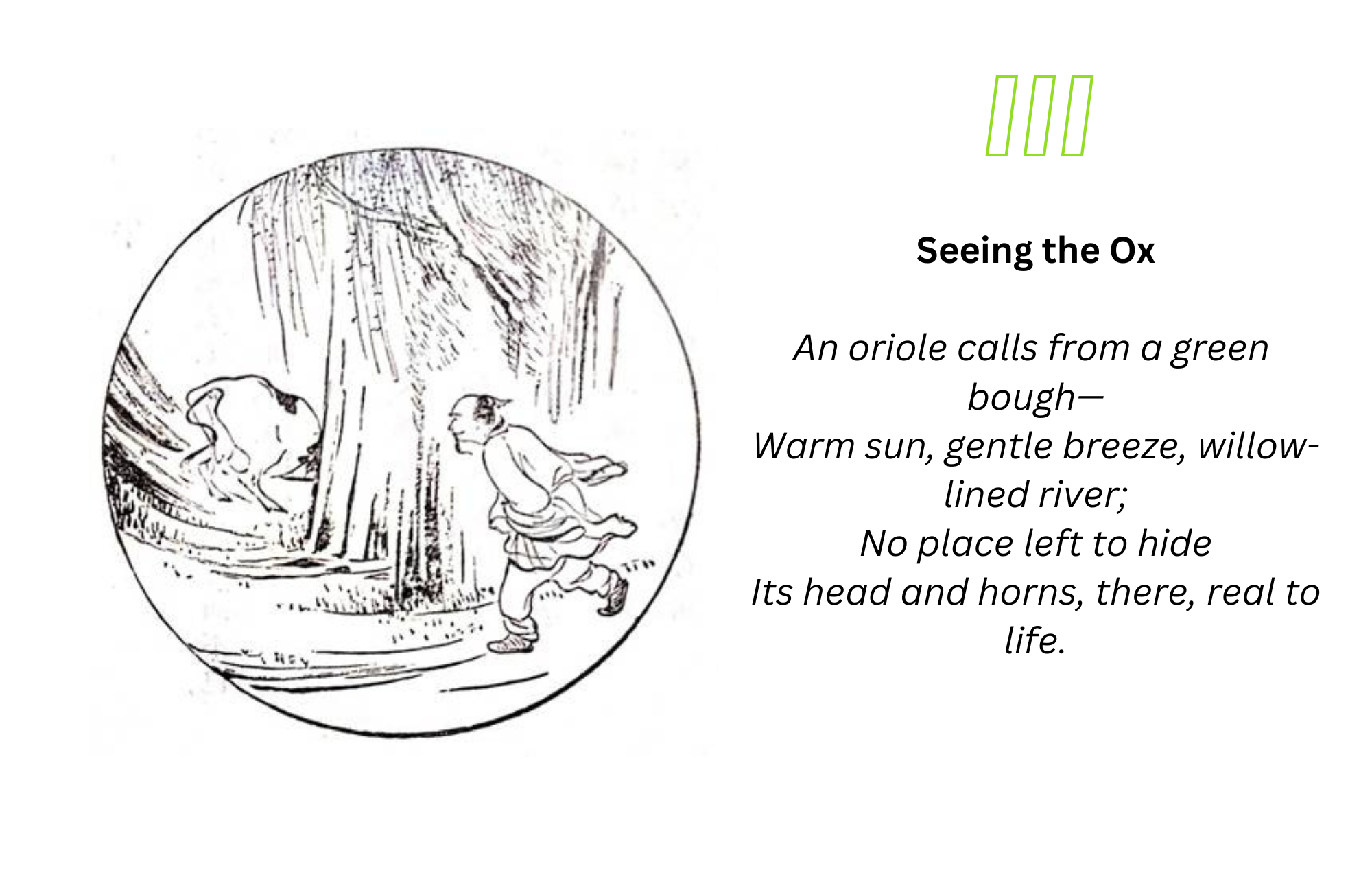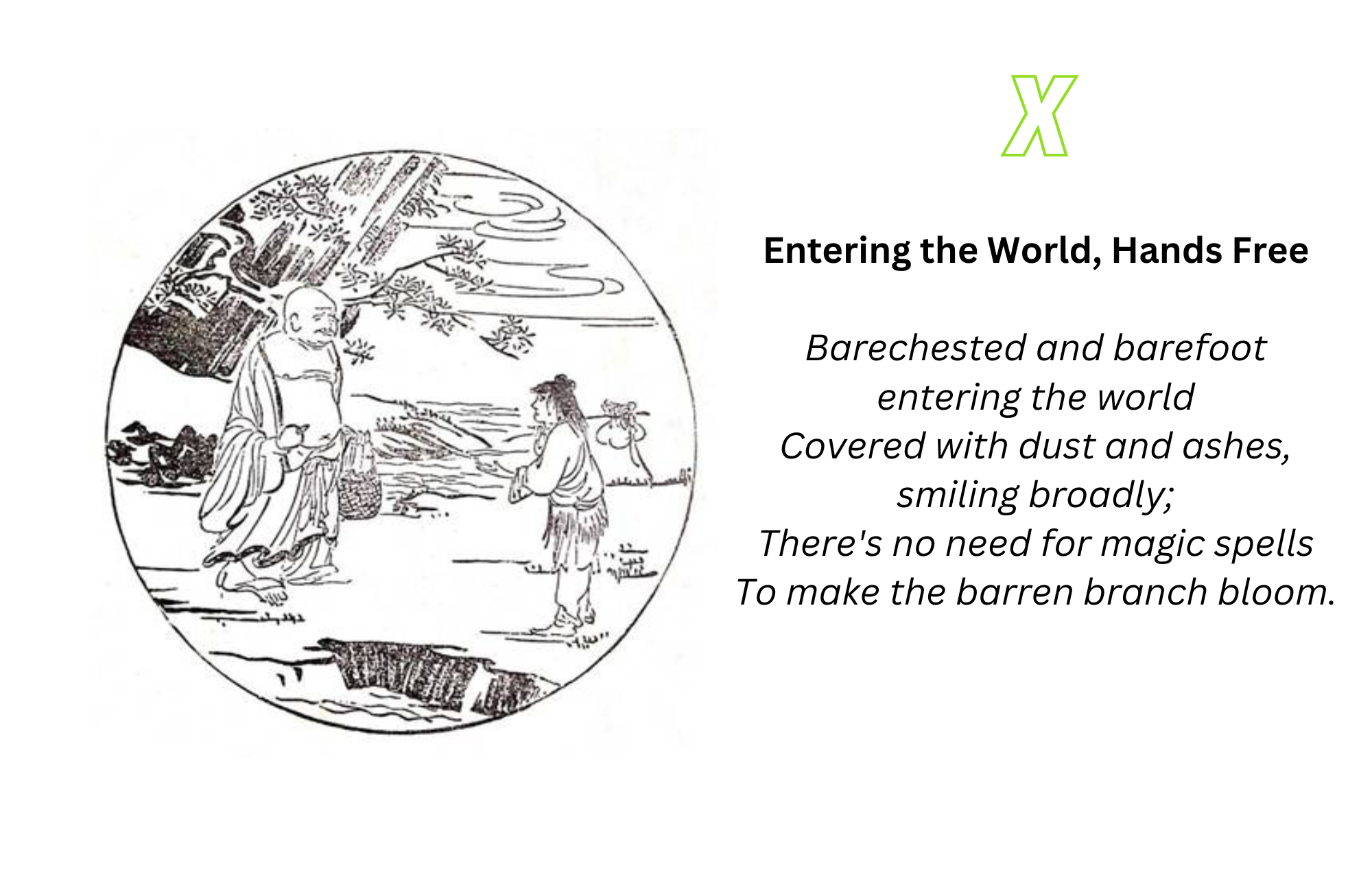THE TEN OXHERDING PICTURES | 十牛圖
…also known as the Ten Bulls
Introduction and commentary by Sensei Michael Brunner
.
Introduction:
The Ten Oxherding Pictures, like a vibrant tapestry woven with hues of profound subtlety, unveils the captivating stages of the spiritual odyssey. Each picture paints a vivid metaphor, breathing life into the timeless journey of the search for our original nature. In a world where we celebrate our individuality, we often perceive our spiritual quest as a solitary pilgrimage, detached from the experiences of our fellow seekers. Yet, through the forest of existence, we discover the interconnectedness of all beings, for we are bound by the same universal source. Within this interconnectedness lie the unmistakable markers, the shared footprints, that guide us all on this magical exploration.
The Ten Bulls, a poetic distillation of wisdom, acts as a transformative prism, illuminating the essence of these guideposts. With delicate strokes of insight, it articulates the ineffable, giving voice to the sublime endeavor that unfolds within us. Through vibrant shades and subtle gradients, it beckons us to embark upon this divine adventure, to traverse the landscapes of self-discovery, and to embrace the profound beauty that lies hidden within. As we embark on this colorful pilgrimage of the spirit, we find solace and unity in the understanding that, ultimately, we are all fellow travelers on a shared path toward awakening.
-Sensei Brunner
The spiritual quest at its very onset distinguishes itself as an aspirational gesture reaching out to fathom the very depths of the mystery that surrounds us. The initial casual ruminations are not the genesis of our journey - the burning question is the start. We have to have tried and exhausted any hope of our own intellect laying hold of the matter. Until our inquiry is felt as a grave need to understand our true cosmic inheritance, we haven't laid foot to the path.
There is an old anecdote about the true spiritual seeker:
"A hermit was meditating by a river when a young man interrupted him. "Master, I wish to become your disciple," said the man. "Why?" replied the hermit. The young man thought for a moment. "Because I want to find God."
The master jumped up, grabbed him by the scruff of his neck, dragged him into the river, and plunged his head under water. After holding him there for a minute, with him kicking and struggling to free himself, the master finally pulled him up out of the river. The young man coughed up water and gasped to get his breath. When he eventually quieted down, the master spoke. "Tell me, what did you want most of all when you were under water."
"Air!" answered the man.
"Very well," said the master. "Go home and come back to me when you want God as much as you just wanted air."
The search, therefore, begins not as a quaint longing but a desperate need. When we have exhausted our understanding, searched high and low in vain, and lain down defeated in the tall grass only then can we even hope to begin genuine practice.
All of this said - notice that the quest does not meet with finding. It only acts to exhaust the rational fervor with which we search. Only then does the cicada's chirr and the rustle of the maple break through. This is where the koan: "What is the sound of one hand clapping?" points. Suddenly there is a crack in the door...
As the stage of Searching for the Ox passes, we are left listening to the cicadas in what might seem an anticlimactic result of our efforts to penetrate the Way. In this silence, when our intellect is exhausted, a path begins to be visible and tracks come to the fore.
Perhaps it is through the efforts of our practice that the mind becomes subtly less attached to clinging, or maybe through witnessing the example of fellow seekers in our tradition that we begin to loosen our grip on our constructed reality. Whatever the reason, a path opens before us as we part the brushes of the idle thoughts of the discursive mind.
In this stage we loosen our hold on who we think we are and what we think is and taste the possibility that what actually is, and therefore what we really are, is something much larger. We start to accept the possibility that we need not identify with our thoughts and that our true nature is not embodied in them. The vastness of the mountains beckons us as the ancestors gently wave us on. It has always been as plain as the nose on our face, even though we've fervently searched elsewhere.
Although we are heartened by this glimpse into realization, we may still shudder as we shake off the coil of the small self and conditioned consciousness. Still: we are drawn on. With a small faith we follow the path of life pointing to the mantle of our original nature - the beauty and wonder of which cannot be fathomed, only experienced.
As we are following the tracks, deepening our practice, the glue that holds the small self together becomes less and less effectual and at some point, we catch a glimpse of our true nature.
The image for this stage rings true-to-life. This is a glimpse at the Ox - we see its tail and hind-quarters. It appears to be fleeing, as it avoids being captured by the conceptual, discursive mind. We don't get a long look at it - certainly not long enough to name it. Yet we know we have seen something wondrous. The ox's head and horns may be buried in the brambles, but no real hiding places exist anymore. Seeing the discursive mind for what it is, it no longer obscures the boundlessness our original nature. Now we see through the eyes of Buddhas and ancestors - we hear with the ears of the universe.
When the discursive mind gives way to direct experience, prajna emerges. As our discursive mind begins to quiet, we sense the wonder and beauty around us. We begin to experience interconnectedness and the separation between us and the universe drops away: An oriole calls from a green bough— Warm sun, gentle breeze, willow-lined river.
Our travels are now in the direction of letting go of the discursive mind through cultivating the faith and trust to open and experience the mystery clearly...
In the transition to stage four, we become a little better acquainted with the ox. Having glimpsed at our true nature, we now have a little bit better idea of where to look - it is always just a matter of softening our gaze.
We discover quickly, however, that holding the ox is a different matter. Aspiration is critical to developing a sense of intimacy with our experience. We need to take in the whole counsel of what is coming up for us - and experience directly before the small self takes hold and weaves its own narrative. This takes perseverance, discipline, and practice. There is wrestling with ego - we can now shift our perspective and see it for what it is - strong and stubborn.
Sometimes our true nature is on the high plateau and we bask in the splendor, others it is shrouded in clouds. We cultivate wisdom when oneness is perceived, but staying with that wisdom is a challenge. Our focus shifts wildly between subject and object and boundlessness.
The fourth stage was fraught with conflict as the ego or small self fought back when we began to fathom our original nature. Now we begin the long path of integrating our ox. This is where realization becomes actualization.
The discursive mind follows the well-worn path of a lifetime of conditioning, lashing out when its primacy is challenged. It is still very clear in this stage that even our best intentions aren't enough to stand in the way of our karmic momentum - and that even when we know our responses aren't skillful, they still come to the fore. Through constant repetition and practice, however, we begin to see the possibility of reprogramming our conditioning. We are slowly modeling clarity and turning our principles into expression.
In this stage, we have to remain vigilant. The whip and the tether of constant practice need to be at hand as we resist falling back on past patterns of delusive thought. If we continue to train in this way, the possibility of not dwelling within the confines of the small mind that doesn't serve us begins to become real. Untethered it will follow unforced...
The halting nature of practice in Stage V begins to lead to a more supple, more even practice now. As we sit in more deeply to what is coming up for us and are more disciplined at being present, we begin to truly recognize our true nature and it begins to inform our activity as we dwell in it. The small self is still present, but it is treated with more skill and its limitations are recognized.
This is a very joyful stage, as we begin to appreciate our lives as practice. We ride the ox - meandering homeward. The delusions are dropping away. Taking the time to notice things we hadn't before - the evening clouds, a simple tune - a happiness and comfort emerges that is no longer dependent on our perceived circumstances. There's no expressing it, as it disintegrates under investigation, so we just live it.
The concept of a gaining idea, so prevalent in the stages up until now, begins to lose hold as we relax into practice. There's a possibility of getting 'stuck' here - as there is a tendency to believe we have reckoned with reality and have apprehended it. Having glimpsed at emptiness and impressed the vision into our marrow, we feel we've 'figured it out'.
But even this understanding is still due a more final reckoning as we move beyond these concepts of self, other, and enlightenment. No longer under the power of the small self, the practice begins to do us. Where, then, does "I" go?
In Stage VI ox and man come together and our practice follows the path towards integration. Like a painter behind the easel, we bring our experience of oneness to the canvas of our life with the palette of upaya. But the subject and object here are still at play, and we spend our time shifting between the vantage of our small self and big mind.
Now, in Stage VII, this distinction drops away and the ox is transcended. The various vain cares of the small self drop away and we see through the eyes of the universe. Compassion flows freely, and practice begins to take on a sense of joy rather than striving. We see how the Absolute plays on this dualistic plane and can manifest it. It is no longer other.
There is room here to get stuck, as we identify less with striving and spiritual accomplishment. Practice begins to flow naturally now and life begins to live us. It is, of course, true that rituals and traditions can only point the way and are not needed to light the path for us anymore. It is still vital, however, to leave the signs along the trail intact for the benefit of others. We may even erect a few additional signs to clarify it more.
Here, we're no longer attached to a fixed abiding place anymore. Our hermitage of the self is built with simple materials that were readily available and close at hand. They are meant to provide us with shelter for a season. The ravages of time and tempest - not to mention simple everyday living - will necessitate rebuilding from time to time. As we become more acquainted with our true nature, it will change how we live. The structure of the self will change. With practice, it will drop away.
While Stage VII was categorized by the ox being integrated into self and thus transcended, in Stage VIII both body and mind, self and other fall completely away. Our body then extends in the ten directions - there are no distinctions. As such, we abide neither in enlightenment or delusion - both are void.
Remember back in Stage III we talked about how the glue that holds the small self together was starting to become less effective. Now the self, once transformed, is utterly shot through. This is the dharmakaya, the first of the three bodies of a Buddha (awakened one) in our Mahayana tradition. Dharmakaya is the body of absolute reality itself - it takes on no form of its own. We are identified with everything that is. This emptiness is the vast blue sky that cannot be reached by thoughts - as the skandhas lose their hold here, like snowflakes in a firey stove.
As the Heart Sutra lays out, this place of absolute wisdom is beyond pain and suffering. The wisdom here is not fully actualized, however. Daido Roshi points out that nearly half of the koans in the classic collections speak to getting stuck here and the possibility of turning a blind eye to the world's suffering.
In some schools of Buddhism, this is the apex of spiritual development, the attainment of shunyata. For the Bodhisattva, however, this is not a place to dwell. There is full actualization in line with our vows that compels us to press on.
Stage IX epitomizes sambhogakaya, the body of enjoyment or bliss. We enjoy the truth that we have integrated and embodied. Having realized the shunyata of Stage VIII, we've now traced back to the source and dropped off the dropped off body and mind. We open our hands and walk, innocent. In so doing, the great absolute perfection of wisdom - prajnaparamita - shines forth. It bursts forth as compassion - beginning with the desire to have everyone experience this clarity. The apex is just behind us now as we descend the mountain to fulfill our Bodhisattva Vow. All is clear now, and we witness the simplicity underpinning what appeared so complex to the differentiating small self.
Compassion now operates to resolve the difficulties of life, bringing a sense of ease to our interactions. There is also a sense of preciseness in our action, as clarity reigns. Here, the morality of our intentions is consumed and converted into compassion spontaneously. We dwell lightly and simply, having great faith and trust. We show up without pretense, fully present and available.
Some traditional interpretations of this stage use it to mark the height of the teacher/student relationship. Here, they are both seeing through the same eyes - they realize the same truth. This can be seen as the completion of formal mind-to-mind transmission. The student now descends the mountain - committed by their vows to actualize all they have learned.
Here in Stage X we encounter the nirmanakaya, the physical body entering the world and manifesting the teachings for the benefit of all sentient beings.
We've taken quite a stroll through these stages and are likely taking on some of the trappings of old age. Even so, the process isn't over. We'll continue endlessly down this path, practicing unceasingly.
Although at this stage we have had a complete paradigm shift in how we view things like the self and reality, we still will continue refining that understanding. The dangers of not doing this are all very real, as evidenced by the occasional scandal surrounding teachers.
The self that held us in its grip is now manifested at will using skillful means to determine the appropriate vessel. Now, we master the miracle of manifesting as compassion, healing division with every step.











